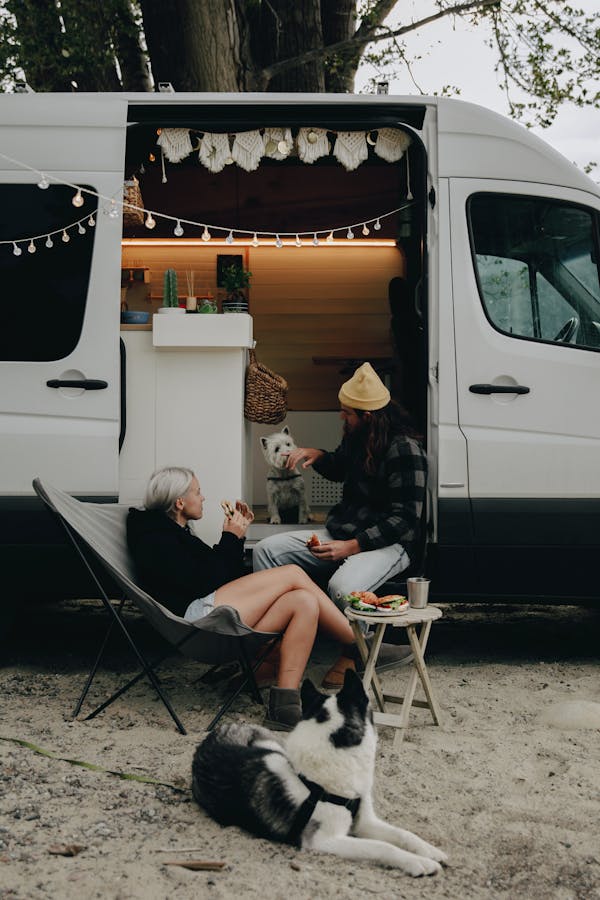Living as a nomad offers the allure of adventure, but reality often reveals a more complex picture. Fabienne and Ben share their personal journey, highlighting the financial uncertainties, wardrobe limitations, and blurring work-life boundaries that come with this lifestyle. Despite the challenges, their passion for freedom and authentic connections shines through. Discover how to navigate the nomadic experience and create your ideal remote workspace, balancing aspirations with practical realities.
Understanding the Nomadic Lifestyle
The allure of the nomadic lifestyle has captivated many seeking freedom, flexibility, and adventure. Whether moving from bustling cities to tranquil landscapes or embracing cultures worldwide, the modern nomadic lifestyle offers a unique way of living. Platforms like rentremote simplify this journey by providing tailored housing solutions with essential amenities for remote workers, bridging the gap between work and exploration.
Additional reading : Exploring British Cinema”s Rich Heritage: Discover the History of Film Studios Through Guided Tours
The Allure and Benefits of Modern Nomadism
The digital nomad life thrives on flexibility. It allows individuals to break free from conventional office settings, offering the ability to work remotely while immersing themselves in rich cultural experiences. This lifestyle fosters personal growth, enhances adaptability, and creates opportunities to network with like-minded global communities. Reduced costs of living in some destinations, such as Southeast Asia, further add to its attractiveness.
Navigating the Challenges
While glamorous on the surface, the nomadic lifestyle presents distinct hurdles. Financial instability requires meticulous planning as incomes fluctuate. Maintaining a work-life balance becomes intricate, especially when professional and personal spaces overlap. Packing light, essential for minimalistic living, can also spark frustration when unforeseen needs arise.
Also read : 42 unforgettable experiences in rome you can't miss
By overcoming these challenges and leveraging resources, such as ergonomic accommodations and flexible rental options, the nomadic journey becomes more feasible and enriching for those bold enough to explore it.
Financial Considerations for Nomads
Budgeting Tips for Digital Nomads
Effective financial planning for digital nomads begins with mastering budgeting to address potential challenges. Variability in income is common; some months might bring substantial earnings while others could fall short. A practical tip is to calculate a baseline monthly expense—covering essentials like accommodation, food, and insurance—and maintain a financial buffer of three to six months’ expenses. This cushion ensures stability during lean periods and unexpected events.
Embracing financial tools can simplify tracking spending habits. Apps focused on expense management can provide insights into areas where costs can be reduced. For instance, opting for co-working spaces with bundled amenities can save on operational expenses while fostering professional connections.
Managing Variable Income
Nomads often deal with irregular income streams, making adaptability key. Dividing income into percentages—such as saving 20%, reserving 50% for fixed costs, and allocating 30% for lifestyle expenses—creates a structured approach. Diversifying income sources, like freelance projects or passive income avenues, helps create a steadier flow and mitigates reliance on a single source.
Some nomads choose destinations with lower living costs, such as Thailand or Bali, allowing their income to stretch further. Targeting digital nomad-friendly locations with budget-friendly housing and food choices reduces financial strain.
Long-term Financial Planning Strategies
Long-term travel strategies include setting retirement savings aside, even with an inconsistent income. Nomads can explore international retirement accounts or financial advisers familiar with mobile lifestyles. Additionally, maintaining health insurance for international travelers protects against unforeseen medical expenses, securing peace of mind while on the move.
Finding Remote Work and Housing
Popular Remote Job Platforms
For those delving into modern nomadic lifestyles, finding employment that supports mobility is vital. Online platforms like Upwork, Toptal, and We Work Remotely are tailored for freelancers and remote workers, offering opportunities across industries. Whether you’re a graphic designer, programmer, or content creator, these networks provide access to roles that align with a life on the move. Networking through platforms such as LinkedIn can further expand job possibilities.
How to Choose Accommodations
Accommodations play a crucial role in balancing work and travel. Look for spaces that prioritize remote work essentials, such as high-speed internet and quiet environments. Options include serviced apartments, co-living spaces, or platforms like Rent Remote, which offers fully furnished apartments equipped for remote work. Consider factors like proximity to amenities, safety, and local culture to enrich your experience with cultural immersion as a nomad.
Overview of Rent Remote and its Offerings
Rent Remote enhances the advantages of being a nomad by curating apartments in hubs like Lisbon and Barcelona. Their properties feature ergonomic workstations and flexible rental terms, making them ideal for digital nomads. Seamlessly combining comfort and productivity, Rent Remote supports modern nomadic lifestyles with community-focused living options.
Building a Nomadic Community
Joining Nomadic Groups
For those embracing the modern nomadic lifestyle, joining nomadic groups is a gateway to connection and shared experiences. These communities, both online and offline, provide a platform to exchange travel tips, insights on adapting to new cultures, and even alerts about remote work essentials. Platforms like social media groups or nomadic meetups can bridge gaps and foster genuine connections, helping members build a collective sense of identity and support on the road.
Engaging with Local Cultures
Cultural immersion as a nomad is vital to deepening your experience in any location. By participating in local events, tasting regional cuisines, or learning a new language, nomads can enrich their journey beyond mere sightseeing. Engaging with local communities not only fosters mutual respect but also creates opportunities to learn from diverse perspectives, helping nomads transition from visitors to contributors in the places they explore. Delving into regional customs elevates connections, building lasting memories and relationships.
Networking Opportunities for Travelers
A strong social life as a digital nomad thrives on active networking. Beyond sharing accommodations or co-working spaces, networking circles can introduce nomads to potential collaborations, remote job opportunities, or new business ventures. These networks are not limited to short-term bonds; they often lead to lifelong friendships and professional partnerships, ensuring that nomads remain involved and connected despite constant movement.
The Psychology of Nomadic Living
Emotional Challenges of the Nomadic Life
Living as a nomad, while rich in experiences, often involves living with uncertainty that can weigh heavily on mental well-being. The unpredictability of finances, housing, and work opportunities can lead to stress, requiring flexibility and resilience to thrive in this lifestyle. Coping with loneliness is another significant challenge—many nomads find themselves missing the deeper connections that come with stationary living, particularly during extended solo travels. Combined with the constant transitions, this can foster feelings of disconnection and vulnerability.
Strategies for Maintaining Relationships
Maintaining relationships while traveling requires deliberate effort. Regular communication through video calls, messages, or shared digital spaces helps bridge the physical gap. For nomads in long-term relationships or families, carving out time for uninterrupted connections strengthens bonds despite distance. Building a supportive nomadic community also reduces isolation and provides a network of like-minded individuals who share similar challenges and joys.
Finding Balance Between Exploration and Stability
A modern nomadic lifestyle thrives on balancing work and exploration. Establishing routines—whether through consistent working hours or revisiting familiar places—offers a sense of stability. Such practices enhance productivity while still allowing the freedom to immerse in cultural experiences and new surroundings. Learning to accept and adapt to impermanence brings emotional equanimity, aiding the transition from place to place.
Practical Tips for Sustaining a Nomadic Lifestyle
Essential Gear for Nomads
Living a modern nomadic lifestyle requires thoughtful preparation and investments in versatile gear. A reliable backpack is indispensable—opt for one with multiple compartments and adjustable straps to distribute weight comfortably. Include compact yet effective essentials like a lightweight sleeping bag, travel-size toiletries, a first-aid kit, and a universal power adapter. High-quality, multi-tool gadgets and wearable tech enhance both utility and convenience during travel.
Packing Light and Smart
Efficiency is key. Limit yourself to clothing pieces that are multipurpose and seasonally appropriate. Fabrics like merino wool ensure comfort in varying climates while requiring minimal maintenance. Packing cubes are game-changers for organizing belongings in tight spaces. For digital nomads balancing work and exploration, allocate room for remote work essentials such as a foldable laptop stand, noise-canceling headphones, and portable chargers.
Eco-Friendly Travel Practices
Sustainable travel for nomads begins with mindful choices. Choose refillable water bottles and reusable utensils to cut down on waste. Prioritize public transport or carpooling to reduce your carbon footprint. Investing in eco-friendly products like solar-powered chargers and biodegradable toiletries can further minimize environmental impact. Cultivating such habits sustains a responsible lifestyle while helping other like-minded communities thrive.
The Future of Nomadic Living
Emerging Trends in Nomadic Living
The modern nomadic lifestyle is undergoing significant transformations, driven by societal shifts and technological advancements. One prominent trend is the rise of flexible working options, enabling individuals to work from virtually anywhere. Popularized by remote job opportunities, cities like Bali and Thailand have become hubs for digital nomad life, offering affordable living, strong internet infrastructure, and vibrant communities.
Another trend shaping this lifestyle is the increasing exploration of van life experiences. With housing markets soaring, over 3 million people in America alone have opted to live in vans, blending mobility with minimalism. Similarly, property guardianship, canal boats, and shared accommodations reflect creative solutions to rising urban costs.
Moreover, sustainable travel for nomads has gained attention, encouraging eco-conscious choices like slow travel and reduced reliance on flights. These habits appeal to individuals seeking both adventure and environmental accountability.
The Role of Technology in Supporting Nomads
Advances in tech continually redefine remote work essentials. Platforms like Rent Remote provide ergonomic lodgings with high-speed internet and customizable terms. Essential tools, like project management apps and cloud storage, streamline work-life integration for those on the move. Additionally, digital nomad visas are expanding, permitting extended stays without violating immigration laws.
Insights on Transitioning from a Stationary to a Nomadic Life
Transitioning to a nomadic lifestyle requires preparation. Start with financial planning for digital nomads, assessing savings and income stability. A minimalist mindset helps simplify packing, balancing necessities and mobility. Building a nomadic community also fosters emotional support and networking opportunities.











